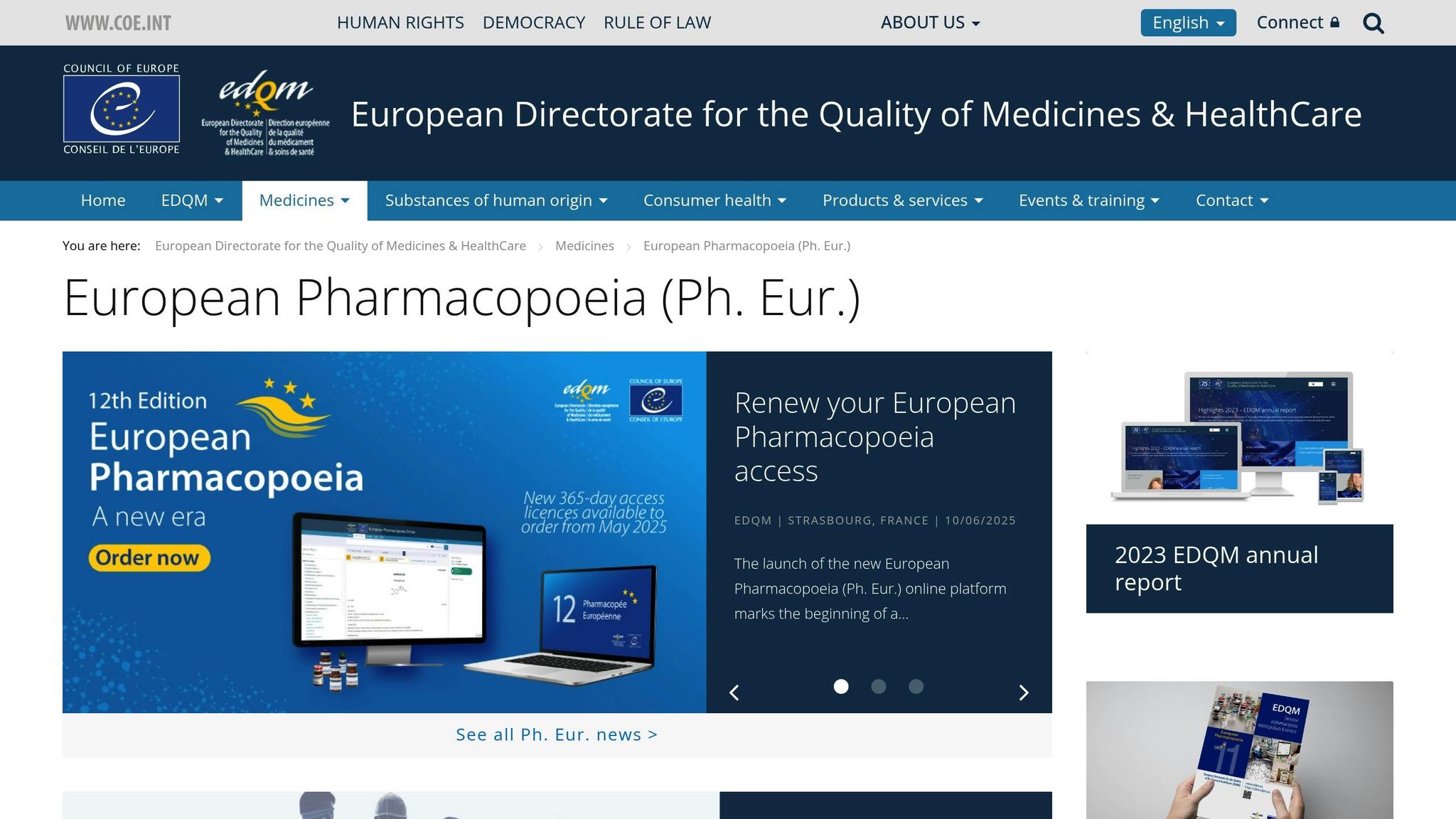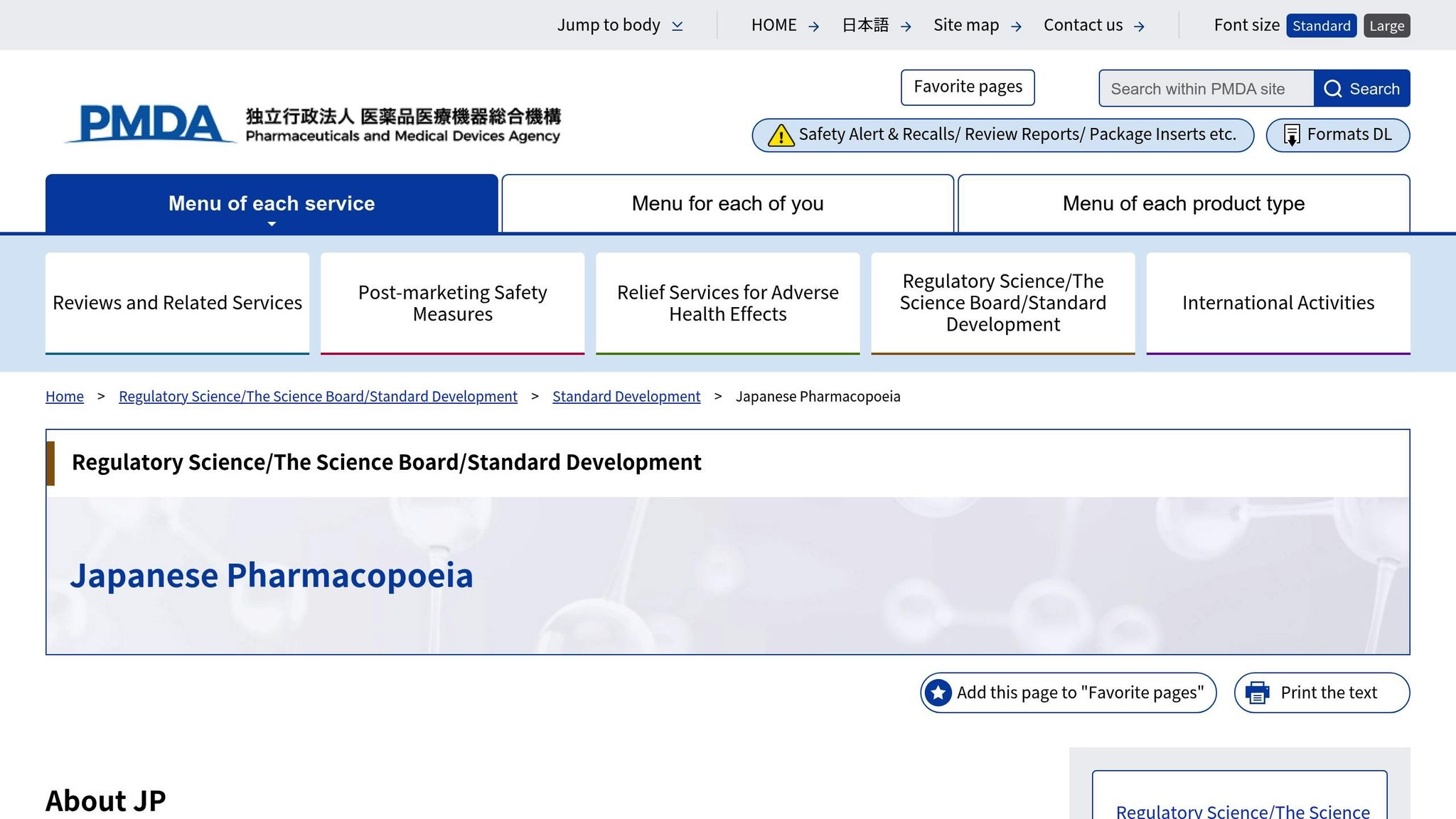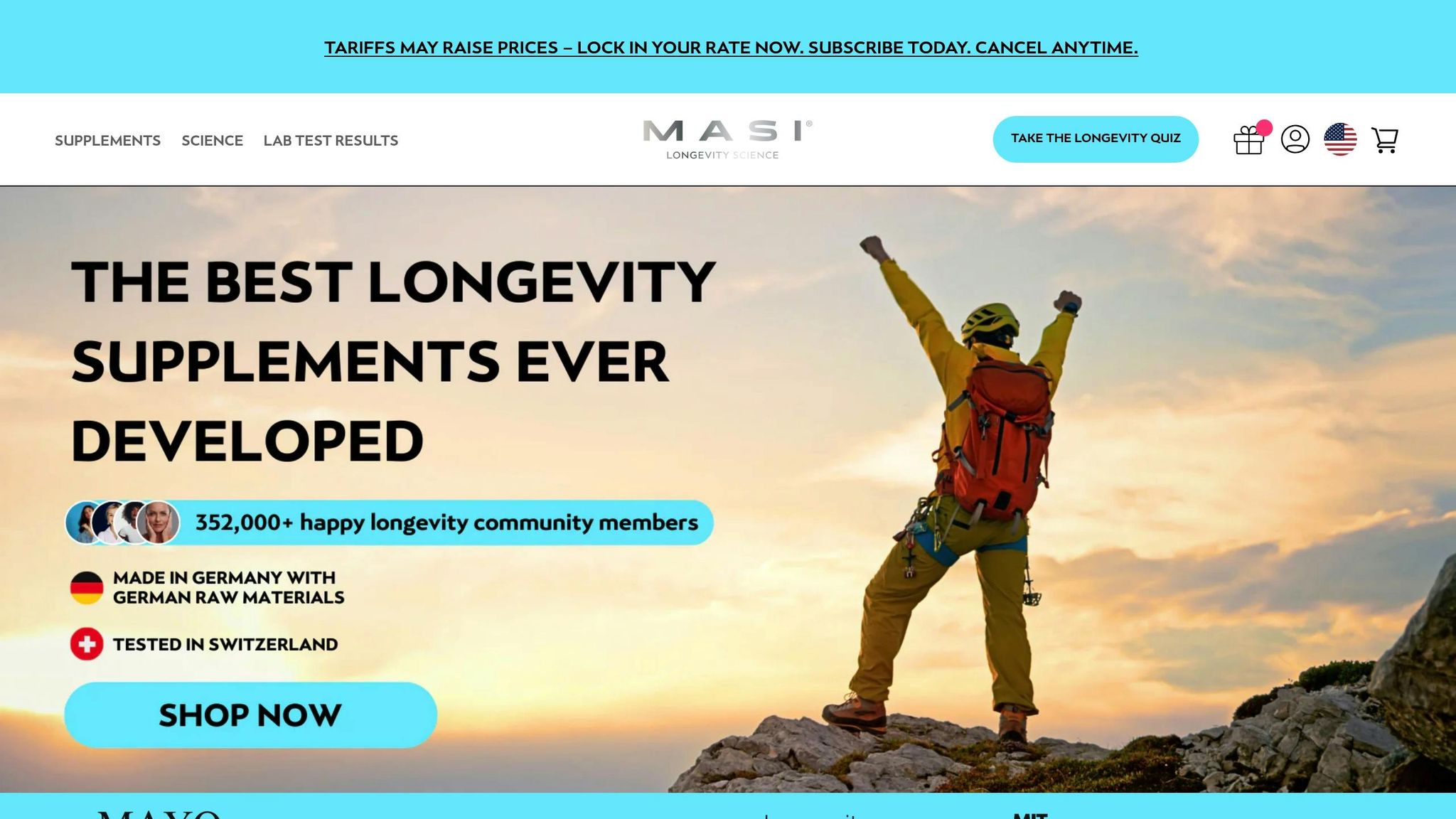How do you ensure supplements meet the highest quality standards? By following pharmacopoeial standards - strict guidelines that verify the identity, purity, strength, and quality of ingredients. The three major pharmacopoeias are:
- USP (United States Pharmacopeia): Covers prescription drugs, OTC meds, dietary supplements, and food ingredients. Enforced by the FDA and recognized in 140+ countries.
- EP (European Pharmacopoeia): Focuses on European medicines, including herbal products and packaging standards. Updated every three years.
- JP (Japanese Pharmacopoeia): Balances modern pharmaceuticals with traditional Japanese medicine (Kampo). Operates on a five-year cycle.
These standards matter because they ensure supplements are safe, effective, and meet global regulatory requirements. Below is a quick comparison of USP, EP, and JP:
| Feature | USP (United States) | EP (European) | JP (Japanese) |
|---|---|---|---|
| Scope | U.S. and 140+ countries | Europe | Japan |
| Products Covered | Drugs, supplements, food | Medicines, herbal products | Modern and Kampo medicines |
| Update Cycle | Ongoing revisions | Every 3 years | Every 5 years with updates |
These standards are critical for manufacturers and consumers to ensure product quality and compliance globally.
Compendial Testing, Everything You Need to Know!
What Are USP, EP, and JP Standards
Pharmacopoeial standards act as the quality guidelines for the pharmaceutical and supplement industries, tailored to specific regions but ensuring the same high levels of safety and quality. These standards are published as detailed monographs that outline testing methods, required purity levels, and essential product characteristics for prescription drugs, over-the-counter medications, dietary supplements, and other healthcare products [1][2]. Let’s dive into how each pharmacopoeia approaches these standards.
United States Pharmacopeia (USP)

The United States Pharmacopeia (USP) is a cornerstone of pharmaceutical quality in the U.S., with its reach extending to over 140 countries worldwide. The FDA enforces USP standards, making them a trusted benchmark for ensuring product safety and efficacy [1].
What sets USP apart is its ongoing revision process. Instead of waiting years for updates, USP engages the public in regular reviews and publishes proposed changes every two months in the Pharmacopeial Forum [6]. Its standards cover a wide array of products, including prescription drugs, dietary supplements, and food ingredients. For supplement manufacturers, USP provides precise testing methods and quality specifications to ensure their products meet pharmaceutical-grade requirements.
European Pharmacopoeia (EP)

Since its establishment in 1964 under the European Pharmacopoeia Treaty, the European Pharmacopoeia (EP) has served as the gold standard for quality across Europe [3]. Its standards are legally binding for all member states of the Council of Europe and the European Union [3].
"The purpose of the European Pharmacopoeia is to promote public health by the provision of recognized common standards for use by healthcare professionals and others concerned with the quality of medicines. Such standards are to be appropriate as a basis for the safe use of medicines by patients and consumers." [4]
EP follows a three-year cycle, releasing a new edition every three years with supplementary updates in between [5]. This structured timeline ensures regular updates while giving manufacturers sufficient time to adapt. Decisions within the EP Commission are made unanimously, fostering consensus across European nations [5].
Japanese Pharmacopoeia (JP)

The Japanese Pharmacopoeia (JP), established in 1886, is managed by Japan's Ministry of Health, Labour and Welfare. It covers both modern pharmaceuticals and traditional medicines, reflecting the unique blend of innovation and heritage in Japan’s healthcare system [1][3].
JP operates on a five-year cycle with biannual supplements, striking a balance between thorough evaluation and market stability [6]. For global supplement companies, adhering to JP standards often requires specific adjustments to meet Japan’s distinct regulatory requirements, ensuring compliance in this highly specialized market [3].
How USP, EP, and JP Compare
The United States Pharmacopeia (USP), European Pharmacopoeia (EP), and Japanese Pharmacopoeia (JP) all aim to uphold pharmaceutical quality, but their approaches reflect the distinct regulatory environments and priorities of their regions. For manufacturers working across global markets, understanding these differences is essential for meeting compliance requirements.
What Each Standard Covers
Each pharmacopoeia has a specific focus that defines its scope:
- USP: Covers prescription drugs, over-the-counter (OTC) medications, dietary supplements, and food ingredients [1].
- EP: Places significant emphasis on packaging standards and the lifecycle of pharmaceutical products [3].
- JP: Balances modern pharmaceuticals with traditional Japanese medicine (Kampo), while also mandating unique packaging requirements [3][7].
Testing Methods and Requirements
Testing methodologies also vary across these standards, reflecting their unique priorities:
- USP: Known for advancing biotech testing methods, setting the stage for modern pharmaceutical analysis [3].
- EP: Focuses heavily on herbal products, incorporating specialized testing protocols tailored to its framework [11].
- JP: Leverages advanced techniques like quantitative NMR and genetic purity tests to ensure precision [11].
While all three share a common foundation in quality assurance, the details of their testing protocols often diverge. For international manufacturers, this can mean adjusting products to meet multiple pharmacopoeial requirements, which sometimes results in overlapping or conflicting testing procedures [3][7].
International Coordination Efforts
Efforts to align global standards highlight both the progress and challenges in this area. The Pharmacopoeial Discussion Group (PDG), established in 1989, plays a central role in coordinating among USP, EP, and JP, with the World Health Organization serving as an observer. In October 2023, the Indian Pharmacopoeia Commission joined the PDG, broadening its global representation [9].
"The goal of pharmacopeial harmonization is to achieve uniform public standards, which are truly representative of the global supply chain." - USP [8]
The PDG focuses on harmonizing excipient monographs and general chapters, aiming to ease the burden on manufacturers who would otherwise face varying analytical requirements across regions [9]. Broader international efforts are supported by the International Meeting of World Pharmacopoeias (IMWP), which fosters collaboration among global pharmacopoeias [9].
However, full harmonization remains elusive due to regional regulatory differences and distinct market priorities. For example, in 2019, EP highlighted the importance of international collaboration by introducing stringent impurity controls in response to contamination issues with anti-hypertensive medications (sartans) [10]. Such initiatives underscore both the potential benefits and the complexities of global coordination.
The International Council for Harmonisation (ICH) also plays a role in aligning global pharmaceutical standards, though its scope extends beyond pharmacopoeias to include broader aspects of pharmaceutical development and regulation [9]. These collective efforts shape global quality benchmarks and guide manufacturers in navigating compliance challenges.
sbb-itb-4f17e23
USP vs EP vs JP Comparison Table
Examining the differences between these three major pharmacopoeias side by side helps highlight how they shape supplement quality and regulatory compliance.
| Feature | USP (United States) | EP (European) | JP (Japanese) |
|---|---|---|---|
| Governing Body | United States Pharmacopeial Convention [1] | European Directorate for the Quality of Medicines (EDQM) [1] | Ministry of Health, Labour and Welfare (MHLW) [1] |
| Regional Scope | Primarily USA, with standards recognized in over 140 countries [1] | Applies in Europe and aligns with the EU and Council of Europe [3] | Specific to Japan [3] |
| Legal Status | Enforceable by the FDA in the United States [1] | Binding for the European pharmaceutical industry [3] | Forms the legal basis for all pharmaceuticals in Japan [3] |
| Product Coverage | Prescription drugs, OTC medications, dietary supplements, food ingredients, and devices [1][3] | Chemical, herbal, biological products, homeopathic preparations, vaccines, and radiopharmaceuticals [1] | Chemical and biological products, herbal remedies, including Kampo [1][3] |
| Monograph Count | Over 4,500 monographs [12] | Selectively defined monographs with a focus on herbal products | Monographs tailored to Japanese regulatory needs |
| Testing Specialties | Leader in biotech and biologics testing methods [3] | Extensive protocols for herbal products and packaging standards [3][11] | Advanced techniques like quantitative NMR and genetic purity tests [11] |
| Unique Features | Includes more drug formulation monographs [11] | Features general chapters on herbal impurities [11] | Integrates standards for traditional Japanese medicine [3] |
USP stands out with its broad scope, boasting over 4,500 monographs covering everything from prescription drugs to dietary supplements [12]. EP focuses on herbal product standards and packaging, while JP emphasizes standards specific to Japan, including traditional Kampo medicines. Testing approaches also vary: USP excels in biologics and biotechnology methods [3], EP prioritizes herbal impurity analysis [11], and JP employs advanced tools like quantitative NMR and genetic purity tests [11].
For international manufacturers, these differences can create challenges. Adapting formulations and testing to meet multiple regulatory demands often increases both costs and complexity [3]. These distinctions underscore the stringent quality controls essential in today’s supplement industry.
Why These Standards Matter for Supplements
Pharmacopoeial standards set rigorous benchmarks to ensure the safety, purity, and potency of supplements - key factors for high-quality anti-aging products.
Ensuring Supplement Quality
These standards serve as the backbone for producing supplements that meet pharmaceutical-grade expectations. Detailed monographs outline the requirements for quality, purity, and strength, along with precise analytical testing methods. For anti-aging ingredients like NMN, Resveratrol, or Spermidine, these standards guarantee that every batch delivers the intended potency and remains free from contaminants.
"Pharmacopoeias play a central role in the pharmaceutical industry as they define the quality standards for medicinal products and their manufacture." - Dedecke GmbH [3]
By following these stringent guidelines, manufacturers can avoid problems like adulteration, product recalls, or regulatory penalties. This level of quality control not only ensures a reliable product but also helps meet the expectations of global regulatory bodies.
Meeting Global Regulatory Requirements
These standards do more than just maintain product quality - they also pave the way for global market entry. Compliance with pharmacopoeial standards is critical for securing regulatory approval in different regions. For instance, government regulators in over 40 countries rely on USP standards, and USP physical reference standards are distributed to more than 150 countries worldwide [14]. However, companies aiming for international distribution must adapt to regional variations in testing methods and specifications, which may require adjustments to their quality control processes [3].
"A pharmacopoeia's core mission is to protect public health by creating and making available public standards to help ensure the quality of medicines." - WHO [15]
Efforts to harmonize these standards simplify trade and improve global access to reliable pharmaceuticals [13].
MASI Longevity Science's Standards

MASI Longevity Science exemplifies these standards by using pharmaceutical-grade raw materials and conducting independent testing to verify purity, safety, and effectiveness. Manufactured in Germany under strict European Pharmacopoeia guidelines and tested in Switzerland, MASI products meet international quality benchmarks. This commitment extends across their entire product range - including NMN, Resveratrol, Fisetin, and Spermidine formulations - ensuring consistent potency and purity for over 352,000 members of their global longevity community.
Conclusion
USP, EP, and JP establish strict guidelines to confirm the identity, strength, quality, and purity of pharmaceutical and dietary ingredients. These standards play a critical role in protecting consumers by preventing contamination, adulteration, and subpar products from entering the market. They not only ensure ingredient quality but also foster the trust needed to prioritize consumer safety.
"USP standards are scientifically validated benchmarks that define the identity, strength, quality, and purity of pharmaceutical and dietary ingredients." - Trevor Henderson, Creative Services Director for the Laboratory Products Group at LabX Media Group [13]
The influence of these standards goes beyond individual products. The USP Verified Mark has become the #1 recommended seal by healthcare professionals advising their patients [16]. This confidence comes from rigorous testing protocols designed to guarantee that what’s on the label matches what’s inside the product.
For manufacturers of anti-aging ingredients like NMN, Resveratrol, Fisetin, and Spermidine, adhering to these standards is essential for accurate formulations and delivering effective benefits. MASI Longevity Science exemplifies this commitment by manufacturing in Germany under European Pharmacopoeia guidelines and conducting independent testing in Switzerland, ensuring reliable, high-quality supplements for those seeking trusted anti-aging solutions.
The alignment of USP, EP, and JP standards serves as the foundation for global supplement safety and product reliability.
FAQs
What are the main differences between USP, EP, and JP standards in terms of product coverage?
The USP (United States Pharmacopeia), EP (European Pharmacopoeia), and JP (Japanese Pharmacopoeia) cater to different regions, each addressing unique regulatory and market needs for pharmaceuticals and supplements.
- USP is primarily used in the U.S., covering drug substances, excipients, and dietary supplements. While its main focus is the U.S., it’s also recognized internationally.
- EP serves Europe, emphasizing pharmaceuticals and gases, with ongoing efforts to harmonize standards across borders.
- JP is specific to Japan, reflecting local manufacturing practices and regulatory requirements tailored to the Japanese market.
In short, USP stands out for its global reach, EP addresses Europe’s pharmaceutical landscape, and JP is crafted for Japan’s distinct needs.
How do the update cycles of USP, EP, and JP affect supplement and pharmaceutical manufacturing?
The update cycles of USP, EP, and JP are key to keeping the pharmaceutical and supplement industries in step with cutting-edge science and regulatory demands. These updates ensure manufacturers can meet compliance requirements, enhance product quality, and adjust to changing standards.
Take USP as an example - it consistently revises its guidelines, such as during the 2020–2025 cycle, to incorporate the latest research and industry best practices. Efforts to harmonize standards between pharmacopoeias, like USP and JP, aim to streamline global regulatory frameworks, making life easier for manufacturers. These updates influence critical areas like formulation, quality control, and regulatory strategies, ensuring the production of supplements and pharmaceuticals that are safe, effective, and of high quality worldwide.
Why is it important to harmonize pharmacopoeial standards globally, and what challenges does this process face?
Ensuring pharmacopoeial standards align across the globe plays a crucial role in maintaining consistent quality, safety, and effectiveness of medicines. When these standards are unified, it simplifies international regulatory processes, eliminates unnecessary testing, and speeds up drug approvals. This ultimately helps make essential treatments more accessible to patients worldwide.
That said, achieving this alignment isn’t without its hurdles. Differences in regulatory frameworks, scientific methodologies, and even geopolitical dynamics can create significant roadblocks. Addressing these challenges is critical to making drug development more efficient and ensuring patients everywhere have access to trustworthy and effective medications.




